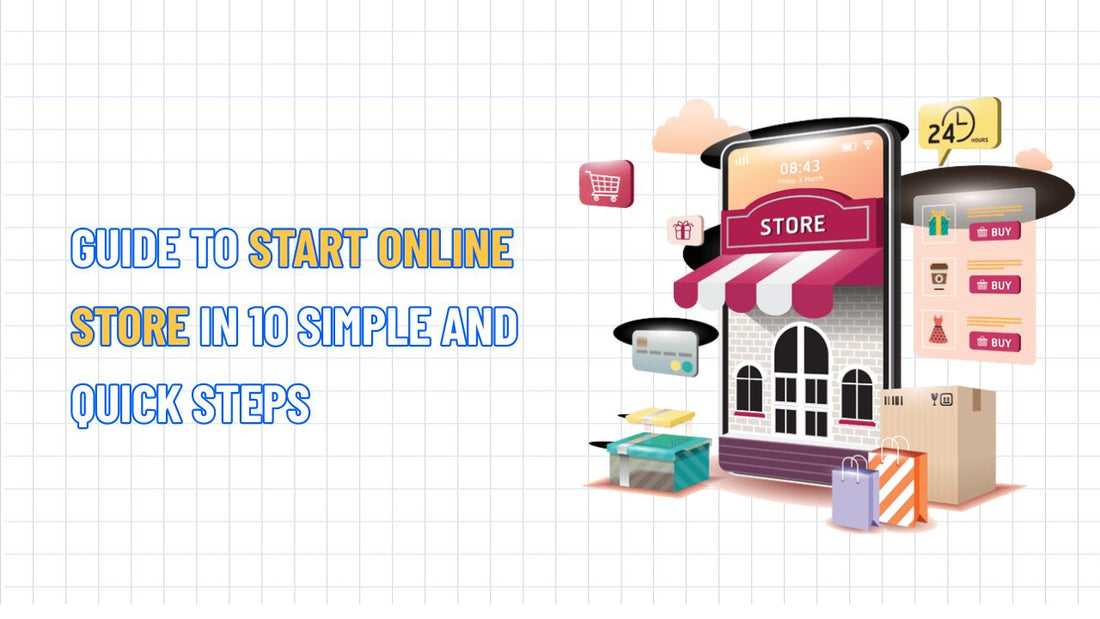Guide to Start Online Store in 10 Simple and Quick Steps
Table of Contents Hide
Start online store in 2025 offers a golden opportunity to tap into the multibillion-dollar e-commerce market. Whether you're an aspiring entrepreneur or an established business looking to expand your digital presence, building an online store has never been more accessible. In this article, NextSky provides a detailed roadmap for launching a successful online store and standing out in a competitive market.
How to start an online store in 10 effective steps
Step 1: Define your business vision and target audience
Before diving into the technical setup, clearly define your business goals and target customers. A well-defined vision ensures every decision aligns with your brand's direction and maintains consistency in your growth strategy.

Identify your niche
Choosing a niche helps you stand out in a crowded market. Research market trends and consumer needs to find a gap. For example:
- Broad market: Pet supplies.
- Niche: Eco-friendly, biodegradable pet toys for environmentally conscious pet owners.
Expert tip: Use tools like Google Trends or social media platforms to identify growing interests. For instance, searches for "eco-friendly pet products" increased by 25% year-over-year (as of 2024).
Define your target audience
Create a detailed customer persona to guide your marketing and product strategies. Consider:
- Demographics: Age, gender, income level.
- Location: Local, national, or global customers.
- Interests: Hobbies, values, or lifestyle preferences.
Example: For eco-friendly pet toys, your audience might be 25–45-year-old pet owners who prioritize sustainability and shop on platforms like Instagram.
Set clear business goals
An effective plan starts with specific, measurable goals. Ask yourself:
- Are you aiming for a side hustle or a full-time business?
- Will you focus on physical products, digital goods, or services?
- What's your timeline for profitability?
Action step: Write a mission statement. For example, "Providing eco-conscious pet owners with sustainable, high-quality pet toys to enhance pet wellness."
Read more: TOP 30+ Best Shopify Stores of a Year that You Shoudn't Miss
Step 2: Source your products or services
Selecting the right products is the foundation of your Shopify store's success. Focus on items that align with your niche and meet the needs of your target audience.
Common sourcing models
- Dropshipping: Partner with suppliers who handle inventory and shipping. Ideal for beginners due to low upfront inventory costs.
- Print-on-demand: Customize products like t-shirts or mugs, produced only after orders are placed.
- Wholesale: Purchase bulk inventory for better control over products and branding.
- Handmade or exclusive products: Create unique items if you have crafting or design skills.
- Digital products: Sell e-books, courses, or digital art for high margins and no storage needs.
NextSky's Shopify themes, such as Glozin or Umino, are optimized to showcase a diverse range of product types from physical goods to digital downloads with fast-loading pages and SEO-friendly designs.
Research product demand
- Engage with communities: Join forums or social media groups to gain a deeper understanding of customer pain points.
- Analyze trends: Use platforms like Amazon or Etsy to spot top-selling products.
- Validate ideas: Test product concepts with surveys or pre-orders before committing to them.
Action step: Start with a small product catalogue (5–10 items) to test demand, then expand based on sales data.
Step 3: Choose the right e-commerce platform
Your platform is the backbone of your online store. Shopify stands out for its ease of use, scalability, and robust features, making it a top choice for 2025.

Why choose Shopify?
- User-friendly: Drag-and-drop tools simplify store creation.
- Customizable themes: NextSky themes (e.g., Agile, Umino) offer mobile-responsive, SEO-optimized designs.
- Integrated tools: Manage payments, shipping, and analytics in one dashboard.
- Scalability: Grow from a small store to a global brand without needing to switch platforms.
- App ecosystem: Enhance functionality with apps for marketing, inventory management, or SEO.
Compare alternatives
- Wix: Affordable but less robust for scaling e-commerce.
- WooCommerce: Flexible for WordPress users but requires technical setup.
- Amazon: Great for instant customer reach, but limits brand control.
Expert tip: NextSky's Glozin theme features parallax scrolling and customizable layouts, making it ideal for visually engaging stores.
Read more: Top 10 Strategies to Get Products Stocked in Retail Stores
Step 4: Design your brand identity
A strong brand builds trust and leaves a lasting impression. Your store's design should reflect your core values to attract and inspire your target audience.
Key brand elements
- Store name: Choose a memorable, brand-aligned name. Use Shopify's domain name generator for ideas.
- Logo: Create a versatile and straightforward logo using tools like Canva or Shopify's logo maker.
- Colour palette: Select colors that evoke your brand's personality (e.g., green for eco-friendly products).
- Imagery: Use high-quality product and lifestyle photos to showcase your offerings.
Create a consistent experience
Consistency makes your brand professional and memorable. Ensure your brand style is cohesive across:
- Website design
- Product packaging
- Social media profiles
- Email marketing campaigns
Read more: DIY Ecommerce Store Design for Beginners: Building a Website
Step 5: Register your business
Complying with legal requirements ensures your business operates legitimately, builds credibility, and fosters customer trust. Setting up the proper structure and completing necessary paperwork lays the foundation for sustainable growth.

Choose a business structure
- Sole proprietorship: Simple, no formal registration, but personal assets are at risk.
- LLC: Protects personal assets, ideal for small businesses.
- Corporation: Complex but suitable for large-scale operations.
Obtain licenses and permits
- Check local regulations for business or sales tax permits.
- Register for an EIN (in the U.S.) for tax purposes.
Comply with sales tax
- Utilize Shopify's built-in tax tools to automate sales tax collection based on customers' locations.
- Consult a tax professional to ensure compliance with state-specific regulations.
Action step: Research state requirements via the Small Business Administration (sba.gov) or consult a lawyer.
Step 6: Build your online store
With your platform and brand ready, it's time to construct your online store.
Set up basic store information.
- Domain: Purchase a custom domain (e.g., yourstore.com) for a professional appearance.
- Theme: Choose a NextSky theme like Umino for fast performance and SEO optimization.
- Navigation: Create intuitive menus that link to key pages (home, shop, about, and contact).
Add products
- Titles and descriptions: Write keyword-rich, clear titles and descriptions (e.g., "Eco-friendly bamboo dog toy – durable and sustainable").
- Images: Use high-resolution photos with consistent styling.
- Variants: Include options like size or colour.
- Pricing: Consider costs, competitor prices, and perceived value.
Create essential pages
- Home: Highlight top products and your brand story.
- About: Share your mission and values to connect with customers.
- Contact: Include a form, email, and live chat options.
- Policies: Detail shipping, returns, and privacy policies.
- FAQ: Address common questions to reduce customer inquiries.
Action step: Use Shopify's store builder to set up your site, then customize with a NextSky theme for a professional look.
Step 7: Set up payments and shipping
A seamless checkout process turns visitors into paying customers. Optimizing this experience boosts order completion rates and customer satisfaction.

Configure payment methods
- Shopify Payments: Use Shopify's built-in solution for fast, secure, cost-effective transactions.
- Diverse options: Offer popular payment methods, including credit cards, PayPal, and Apple Pay, for added convenience.
- Multi-currency support: Enable multi-currency features to serve global customers and expand your reach.
Set up shipping methods.
- Flat rates: Ideal for products with similar weight or size, simplifying cost calculations.
- Carrier-calculated rates: Automatically update costs based on weight, location, and delivery time.
- Free shipping: Offer for orders above a minimum value to encourage larger purchases.
- Local pickup: Allow nearby customers to collect orders, saving costs and adding flexibility.
Optimize checkout
- One-tap checkout: Enable Shop Pay or similar for quick order completion.
- Guest checkout: Allow purchases without account creation to reduce barriers and speed up conversions.
- Upsell prompts: Add innovative suggestions or add-on offers to boost order value.
Action step: Test the entire checkout process on mobile and desktop to ensure it's smooth, intuitive, and secure, delivering a seamless experience from cart to completion.
Step 8: Launch your store
Ensure your store is prepared to deliver a seamless customer experience from the very first visit.
Pre-launch checklist
- Test navigation, links, and checkout functionality to ensure a seamless user experience.
- Optimize for mobile (over 45% of e-commerce traffic is mobile-driven).
- Verify SEO settings (meta titles, descriptions, image alt text).
- Remove password protection to make your store public.
Soft launch
- Share your store with a small group (friends, family, or loyal followers) for feedback.
- Monitor analytics to identify usability issues.
Action step: Announce your launch via social media and email with a limited-time discount to drive initial traffic.
Step 9: Market your store
Effective marketing drives traffic and sales. Combine organic and paid strategies for maximum impact.

Optimize SEO
- Use keyword-rich titles and descriptions (e.g., "how to start an online store").
- Optimize images with alt text.
- Create blog content targeting long-tail keywords, such as "how to start an online store with no inventory."
Social media marketing
- Focus on platforms where your audience is active (e.g., Instagram for Gen Z).
- Share engaging content, such as product demo videos, behind-the-scenes footage, or customer testimonials, to captivate your audience and build trust.
Email marketing
- Build a subscriber list with lead magnets (e.g., a free eco-friendly pet care guide).
- Send welcome emails, abandoned cart reminders, and promotional offers.
Paid advertising
- Run Google Shopping ads to boost product visibility.
- Use social media ads with precise audience targeting.
Action step: Start with a small ad budget ($50–$100/month) and track performance to refine your strategy.
Read more: TOP 45 SEO Checklist Online Stores that Merchants Cann't Miss
Step 10: Optimize and scale your store
A successful online store doesn't stop at launch. Continuous analysis, improvement, and expansion keep your brand growing sustainably.
Analyze performance
- Use Shopify analytics to track traffic, sales, and user behaviour.
- Identify top-performing products and focus on them.
- Monitor bounce rates and cart abandonment to improve user experience.
Collect customer feedback
- Send post-purchase surveys to gain a deeper understanding of customer needs and preferences.
- Address pain points (e.g., unclear shipping policies) immediately.
Scale your business
- Expand your product line in response to demand.
- Explore new sales channels (e.g., Amazon, Instagram).
- Invest in advanced features, such as custom APIs, available through NextSky's services.
Action step: Set up weekly analytics reviews to identify trends and opportunities.
How to start an online store with no inventory
For those looking to minimize upfront costs, inventory-free models are ideal:
- Dropshipping: Partner with suppliers to fulfill orders..
- Print-on-demand: Sell custom-designed products. Ideal for creatives but limited to printable items.
- Affiliate marketing: Earn commissions by promoting other brands' products. Requires strong marketing skills.
- Digital products: Sell courses, e-books, or templates for high margins and no logistics.
Expert tip: Shopify's ecosystem supports all these models, and NextSky's themes enhance product presentation for better conversion rates.
Building an online store in 2025 is a powerful way to bring your business vision to life. With Shopify's intuitive platform and NextSky's high-performance themes, you can create a professional store that attracts and retains customers. Follow this roadmap to launch, market, and scale your store for lasting success in the competitive e-commerce landscape.









